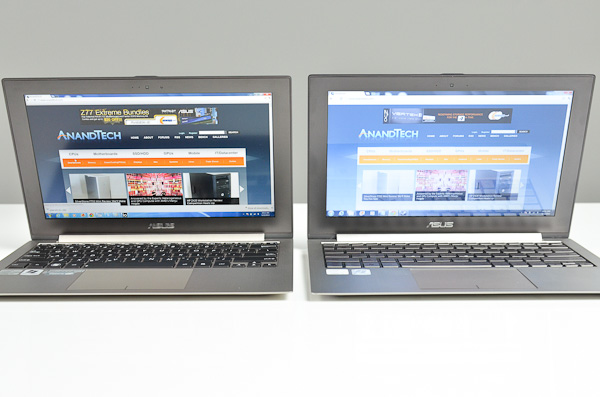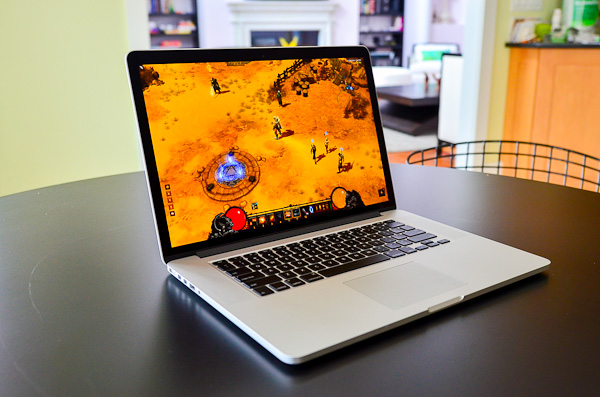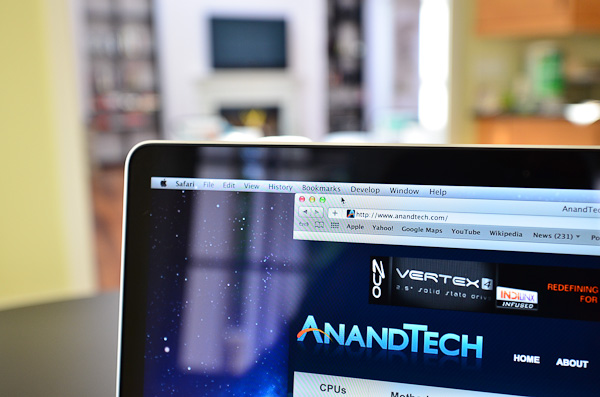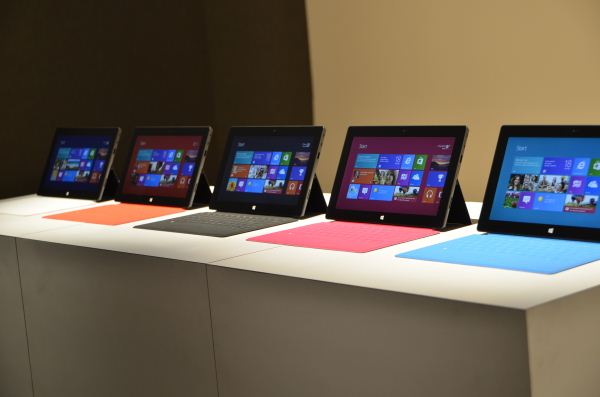The next-gen MacBook Pro with Retina Display Review
by Anand Lal Shimpi on June 23, 2012 4:14 AM EST- Posted in
- Mac
- Apple
- MacBook Pro
- Laptops
- Notebooks
Final Words
Apple has done an incredible job with the next-gen MacBook Pro. It brings a level of portability to the 15-inch chassis that we’ve never seen before from Apple, all while getting a good handle on some of the thermal and noise issues from last year’s model. If you’re like me and have to lug your 15-inch MBP around, the improvements in portability alone are worth the upgrade. But a lighter chassis is hardly all Apple is relying on to sell this system.
The internals are easily the best collection of parts Apple has ever assembled. Ivy Bridge and Kepler are natural fits, but shipping the machine with 8GB of memory by default is a much appreciated gesture especially considering its un-upgradeable nature. For the first time in Apple’s history of shipping NAND flash based storage in Macs, I actually have no complaints about the controller choice in the rMBP. Samsung’s PM830 (or the consumer, SSD 830, version) is what I’ve been recommending to Mac users for much of the past year. It’s still possible that you’ll end up with a non-Samsung controller, and I don’t yet know whether or not that’s a bad thing, but this is at least progress.
The connectivity story on the rMBP is near perfect. The pair of Thunderbolt ports allows extra flexibility as well as the ability to drive more bandwidth to external IO than any prior portable Mac. The Thunderbolt teething issues still remain unfortunately, but it looks like that’s going to require at least a partial act of Intel to rectify. USB 3.0 is a welcome addition to the Mac family. It took both Apple and Intel far too long to get to this point, but I’m glad it’s here.
All of this is really just wrapping however, as the real gift is the MacBook Pro’s first Retina Display. It’s easily the most beautiful display I’ve had the opportunity of using. Even more impressive to me than the iPad’s Retina Display, and enough to make me actually want to use the Mac as a portable when at home rather than tethered to an external panel. The added portability of the chassis likely contributes to that fact though.
The credit Apple deserves for the display extends beyond simply pushing LG to get a panel out on time and in large enough quantities. There’s a tremendous amount of software work that Apple put into making the Retina experience work under OS X. The OS and several key applications have been updated to properly support the MacBook Pro’s Retina Display, and things can only get better from here. Mountain Lion will improve performance and I would expect at least a few key app updates over the next year to bring increased Retina awareness.
There’s also the behind the scenes work Apple put in to make all of this happen. The pressure on the GPU vendors, as well as taking matters into its own hands with writing scaling and filtering routines to deliver a good experience are all noteworthy.
It’s because all of this that I’m doing something I’ve never done before in an Apple review. We rarely give out Editor’s Choice awards at AnandTech, and I’m quite possibly the stingiest purveyor of them. I feel that being overly generous with awards diminishes their value. In this case, all of the effort Apple has put into bringing a Retina Display to the MacBook Pro is deserving of one.
 I’m giving the MacBook Pro with Retina Display our bronze Editor’s Choice award. Making it the first Mac to ever receive one. It would have been a silver had the software story been even stronger (iWork, Mountain Lion, Office and Photoshop being ready at launch would have been a feat worth rewarding). And it would have been a gold had Apple been able to deliver all of that but without sacrificing end-user upgradability. Which brings me to my final point.
I’m giving the MacBook Pro with Retina Display our bronze Editor’s Choice award. Making it the first Mac to ever receive one. It would have been a silver had the software story been even stronger (iWork, Mountain Lion, Office and Photoshop being ready at launch would have been a feat worth rewarding). And it would have been a gold had Apple been able to deliver all of that but without sacrificing end-user upgradability. Which brings me to my final point.
I accept the fact that current mobile memory and storage form factors preclude the creation of the thinnest and lightest form factors. But I would like to see Apple push for the creation of industry standard storage and memory form factors that wouldn’t hinder the design of notebooks like the Retina Display equipped Macbook Pro. As Apple has already demonstrated that it has significant pull with component vendors, this should be possible. The motivation behind doing so is no different from the motivation driving the use of Retina Displays: for the betterment of the end user experience.
Sidebar: Impacting the Rest of the Industry

ASUS Zenbook Prime (left) vs. Zenbook (right)
Apple’s impact on the industry has already been felt. The threat of Apple bringing Retina Displays to its entire lineup forced ASUS’ hand and gave us 1080p IPS panels in the new Zenbook Primes. This will undoubtedly continue. In the early days Apple simply raised the bar for a focus on industrial design. Apple’s influence quickly expanded to touch everything from packaging to trackpads. We’re now seeing PC OEMs focus far more on experience than they ever have before. Apple isn’t the only one to thank for this, but the company is a significant factor.
The fact of the matter is the days of blaming a lack of innovation on cost or the inflexibility of one’s suppliers are over. In fact, those days are long gone. Today the MacBook Pro with Retina Display exists at a very high starting price, but make no mistake, it won’t remain there indefinitely. Apple introduced this model as the next-generation MacBook Pro because it truly is a preview of what’s to come. Maybe next year’s model won’t be any cheaper, but the one after that definitely will be. Apple has a healthy obsession with high quality displays and it will put its might behind panel suppliers until it can put forth a lineup of top to bottom Retina Displays. There’s no doubt in my mind that within the next 12 - 24 months Apple will introduce an external 4K Retina Display. Whether you love, hate or are indifferent about Apple and its products, its impact on the industry is tangible. PC OEMs now care about display quality and keyboard feel. They care about trackpads and design. There’s only one motivator in this industry stronger than Moore’s Law: experience, and the PC OEMs finally care about that too.
Apple’s success hasn’t been because it is a vertically integrated company. On the contrary, everything Apple has done Acer, Dell, HP, Intel, NVIDIA and Microsoft could have done together. Apple is successful because its competitors have all been selfishly focused on themselves rather than all coming together to build better computers. Based on my conversations with Intel and some of the OEMs at Computex earlier this month, the wake up call has been heard. Intel seems quite motivated to help its OEM partners do better. It is a bit troubling for the ecosystem that Microsoft is throwing its hat into the ring as a competitor - especially as it was Microsoft's inaction on the software side that really hurt the PC OEMs over the past several years.
For years we’ve been pushing OEMs to focus on better displays, and for years we were given cost and customers-don’t-care as excuses for why we don’t get them. That’s all starting to change.














471 Comments
View All Comments
Fx1 - Monday, June 25, 2012 - link
Whine Whine Whine.In the UK we have the best warranty going thanks to UK Regulations and EU protection. Plus 3 year free on education discounts of which i have bought 2 MBP's and never set foot in a university in my life.
Just because in NZ you don't have that protection then blame your gov for not passing legislation.
Also why bitch about Ram? just put the 16GB in and then your good for the next 10 years i expect. £13 a year cost
Spunjji - Tuesday, June 26, 2012 - link
You're so full of shit it's bursting out at the seams. The NZ government have imposed much better consumer warranty protection than we have here in the UK. You might know that if you weren't a fucking cretin who spouts off nonsense before thinking. The fact that you seem to think it's his fault that he lives in NZ where Apple give shitty support just shows what a jingoistic little fanboy you are.That's also an interesting "£13 a year" theory. It'd be neat if it wasn't a complete and utter crock. If more than 10% of these laptops are used regularly for 10 years, Apple pixie magic included, then I will eat my goddamn chair. Maybe you should have gone to university, they could have slammed some sense into your tiny little skull.
Solidstate89 - Sunday, June 24, 2012 - link
"Apple’s impact on the industry has already been felt. The threat of Apple bringing Retina Displays to its entire lineup forced ASUS’ hand and gave us 1080p IPS panels in the new Zenbook Primes."Isn't that a little fucking arrogant to say with absolutely no proof to back that claim up? You know better than anyone how much design work goes into producing these products, and just how LONG the process takes. You really think in just a few months time of rumors, ASUS could have completely revamped their product line-up? Or maybe they were just doing it, because they had already started with the higher resolution displays on their tablet line-up? Or maybe they were even trying to match the absolutely superb and high density display that Sony has been using in their Vaio Z series for all these years.
Claiming just the RUMOR of Apple doing it was UNDOUBTEDLY the influence behind ASUS' IPS, high resolution screens is baseless bullshit. And you know it.
Iketh - Sunday, June 24, 2012 - link
what i don't get is how people could care so much to get pissed off like you... get a hobby!and i agree 100% with Anand's statement... you're blind to not agree, and i'm a PC developer
wfolta - Sunday, June 24, 2012 - link
ASUS may have decided to carry higher resolution displays from their tablets to their laptops, but Apple beat them to the punch with the retina iPad and the rumors of a retina Macbook have been around since at least that far back.Considering most manufacturers have reduced pixel density over time, and considering it was Apple that pushed the retina display first to the iPhone, then the iPad, I think the burden of proof is on you to say that these netbook makers were just itching for higher resolution.
In fact, most of them stopped at the stupid 16:9 1080p (1920x1080) resolution because that's what HD TVs have and they've wanted to tout their ability to play BluRay's at full resolution. There was no concept of making a beautiful display: it was all about a marketing checkbox. And that's what they guy is saying.
kmmatney - Sunday, June 24, 2012 - link
I'm a windows developer - have been for almost 20 years now. I also travel a lot so all my development is done on a laptop, across several virtual machines. I'm currently using a 2007 Dell 17" 1920 x 1200, and have not upgraded yet, waiting for another windows 1920 x 1200 laptop to surface. I've run out of hope now - if Apple comes out with a 17" version of this I'll have to try and convince my company to buy one. I've never used a Mac in my life, but will pay the "Apple tax" to get what I need hardware-wise. I currently have about 20 VMs packed onto a Samsung 256GB 830, so I'm good with storage space.The Windows laptop makers just don't get it - not everyone watch's movies all day - some of us want to use our machines for real work and want to have extra vertical space. Is it that hard to make a 16:10 screen? An ugraded screen is a "3D" screen - really?! The "True-life" screen on my old 2007 Dell is still better than anything you can get nowadays - I've directly compared it with co-corkers brand-new laptops.
KPOM - Sunday, June 24, 2012 - link
Is it possible that Apple's solution for making the rMBP work will scale to the new iPhone? In other words, does it offer Apple a way to increase the screen size without causing a break in compatibility between older and newer apps?gstrickler - Sunday, June 24, 2012 - link
The iPhone and iPad already handle the HiDPI displays, Apple deployed Retina displays there first. The scaling to non integer resolutions is definitely something Apple could do on the iPhone or iPad, but since it takes significantly more CPU/GPU power and affects both performance and battery life, I would not expect it anytime soon. If Apple goes to a larger screen on either device, it's likely that it will support the same total resolution as the current devices and have slightly lower dpi. If we see a 3.7"-4.3" iPhone display, I expect it to be 960x640, just like the current iPhone with Retina display.They already have 4 native resolutions to support on iDevices, 480x320 and 960x640 on iPhone, 1024x768 and 2048x1536 on iPad. I don't believe they'll want to increase that as it has an impact on the hardware, battery life, and every developer, so while it's possible, I think it's unlikely.
raclimja - Sunday, June 24, 2012 - link
Ingadgethrrmph - Sunday, June 24, 2012 - link
This one is *extremely* close to allowing me to replace a full tower workstation and my current laptop. Apple has built a very, very impressive machine that should be a wake-up call to the industry: Move forward, or be left behind.Even so, it falls slightly short of my ideal specs. If Apple would make the next one a 17" or 18" version (please make it Retina, I love the foresight there :), add a 10-Key section to the keyboard, upgrade to Giga-WiFi-ac-1.3Gbs, upgrade the quantity of internal drive ports (yes plural - I can use up to 5 immediately, if they will fit), and pretty please give us a standard drive connector.
While we're at it, can we have all of the drives running at speeds of at least 6.0Gbs? You know, like putting the drives on the current standard mSATA 6.0Gbs connectors, or even hooking them up to a better, newer, smaller, open standard connector at 12.0Gbs.
That's a lot to ask of course, but if they 'just' managed to make it a 17" Retina display, with three drives, with standard connectors, and WiFi-ac-800Mbs, and managed to do it this year, then I would feel they have done as much as anyone could do in in the time available.
If they miss out on delivering a 17" model this year, then it becomes more of a wide open competition where almost anyone could deliver a competitive product in the 17"+ space. After all, the display actually only has to be better than 1920 x 1200 to exceed the specs of my current laptop display.
Right now Apple appears to have the hardware lead and a fairly big one at that. If such a 17"+ machine appears, as described in any of the scenarios above, then it would solidify Apple's hardware lead. With a move like that, Apple would firmly and aggressively cement its position in every laptop screen size category that matters. They could have a compelling position in perhaps 99% of the laptop market.
It would also satisfy my need to have a portable large display machine that can go on infrequent, but very long trips, where I am sometimes remote, and I often need to be fairly self-sufficient and fault tolerant (ie: fix any of the inevitable data glitches myself).
It would improve my situation very significantly if there were sufficient physical drives to have separate system, data, and auto-backup drives internally. Also, having extremely capable external ports is important. So both keeping the existing wired ones just released on the current 15" Retina model, and adding the nascent WiFi-ac wireless internal hardware that is debuting this year in non-Apple equipment, would be super helpful for enhancing my ability for doing redundant off-machine data backups - just in case the internal auto-backup gets thrashed.
In fact if Apple were able to produce such a machine, I would be virtually forced - in a very pragmatic sense - to shell out the cash, move to the dark side, and purchase my first Apple product, ever.
Yes, after 25 years of computing I would lose my patience with the laggards that comprise the rest of the laptop market. With deep, naughty feelings of dark misgiving, I would both splurge and switch allegiance at the same time. I wonder how many others would do the same?
If this should come to pass, then I would inevitably wonder if Apple's real intentions are as wicked as I fear: To eventually try to lock all of us as 'sheeple', into a proprietary hell on Earth. You know... like Sony's thankfully failed attempts to force 'works only here' on us. Umm... let's see... MMC Memory Sticks, anyone?.
Well, back to Apple: Just sayin'... I would do it... even though I know better.
Hey... isn't Microsoft supposed to be getting back into the hardware business in a big way?
What do you think the chances are of a company like Microsoft and a machine like that...
So you're telling me there's a chance... *YEAH!*
-